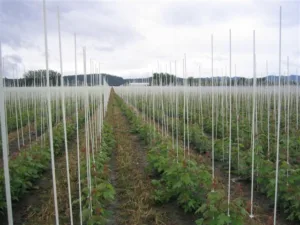Choosing the right tree stakes is crucial for the health and stability of trees, especially in the diverse and challenging Australian climates. This article delves into the pros and cons of fibreglass and wood tree stakes, offering insights to help you make the best choice for your green companions.

fibreglass tree stakes australia
Introduction
In the pursuit of nurturing trees, selecting the appropriate stakes is more than a matter of mere support; it’s about ensuring longevity, growth, and adaptability to environmental challenges. The Australian climate, known for its extremes, demands careful consideration of materials used in gardening and farming practices. This article compares fibreglass and wood tree stakes, exploring their suitability for the Australian environment to assist gardeners and farmers in making informed decisions.
Fibreglass Tree Stakes
Advantages of Fibreglass Stakes
Fibreglass stakes offer remarkable durability and resistance to weather elements, making them an appealing choice for Australian gardeners. Their resilience against rot, decay, and pest infestation stands out, providing a long-lasting support solution for young and growing trees. The lightweight nature of fibreglass also ensures easy handling and installation, a boon for large-scale agricultural activities.
Disadvantages of Fibreglass Stakes
Despite their strengths, fibreglass stakes are not without drawbacks. The initial investment may deter some, as they typically come at a higher cost compared to their wooden counterparts. Additionally, the rigidity of fibreglass can be a double-edged sword, potentially causing injury to trees during high winds or severe weather if not properly installed.
How Fibreglass Stakes Perform in Australian Climates
The performance of fibreglass stakes in Australian climates is a testament to their design and material advantages. Their ability to withstand intense sun exposure, heavy rains, and strong winds makes them an ideal choice for regions experiencing a wide range of weather conditions.
Wooden Tree Stakes
Benefits of Using Wooden Stakes
Wooden stakes have a traditional appeal, blending seamlessly with natural surroundings. They offer a cost-effective solution for staking trees, with the added benefit of being biodegradable. This makes them an environmentally friendly option, aligning with sustainable gardening and farming practices.
Drawbacks of Wooden Stakes
The main challenges with wooden stakes arise from their susceptibility to environmental factors. Moisture, termites, and fungi can degrade wood, shortening its lifespan and reducing its effectiveness as a support structure. Regular maintenance and replacement are necessary to combat these issues.
Wooden Stakes and Australian Weather Conditions
In the diverse Australian climate, wooden stakes face the challenge of maintaining their integrity. In humid and wet regions, wood rot can accelerate, while dry and arid areas may cause cracks and splits. Selecting treated wood or species with natural resistance to decay can mitigate these effects to some extent.
Comparative Analysis
Durability in Harsh Weather
When it comes to withstanding harsh weather conditions, fibreglass stakes generally outperform wooden stakes. Their non-corrosive and weather-resistant properties ensure a longer lifespan, offering reliable support through varying climate conditions.
Sustainability and Environmental Impact
Wooden stakes, being biodegradable and produced from a renewable resource, have a lower environmental footprint. However, the treatment processes for enhancing wood resistance can involve chemicals that detract from their eco-friendliness. Fibreglass stakes, while not biodegradable, require less frequent replacement, contributing to waste reduction.
Cost-Effectiveness
Evaluating cost-effectiveness involves considering initial costs against lifespan and maintenance requirements. While fibreglass stakes may have a higher upfront cost, their durability and low maintenance can make them more economical over time. Wooden stakes, though cheaper initially, may require more frequent replacements and treatment, increasing long-term expenses.
Suitability for Different Types of Trees
The choice between fibreglass and wood stakes may also depend on the type of trees being supported. Fast-growing, heavy-canopied trees may benefit more from the sturdy support of fibreglass, whereas smaller, slower-growing species might be adequately supported by wooden stakes.
Expert Opinions
Insights from Horticulturists
Horticulturists emphasize the importance of considering the specific needs of the tree species, as well as the local climate, when choosing between fibreglass and wooden stakes. They advocate for a balanced approach, weighing the pros and cons of each material based on practical experiences and scientific understanding.
Feedback from Australian Farmers
Australian farmers, with their hands-on experience in diverse climates, often prefer fibreglass stakes for their durability and low maintenance. However, many also value the sustainability of wooden stakes, especially in organic farming practices where environmental impact is a primary concern.
Customer Experiences
Success Stories with Fibreglass Stakes
Many gardeners and farmers report positive outcomes using fibreglass stakes, citing their longevity and resilience as key factors in their success. Their ability to endure extreme weather without deterioration provides peace of mind and reduces the need for frequent stake replacements.
Challenges Faced with Wooden Stakes
Conversely, some users have encountered issues with wooden stakes, particularly in terms of rot and pest infestation. These challenges often lead to additional labor and costs in replacing stakes, highlighting the need for careful consideration of stake material in relation to environmental conditions.
Conclusion
Choosing the right tree stakes for Australian climates involves a careful assessment of the benefits and limitations of fibreglass and wood materials. While fibreglass stakes offer superior durability and low maintenance, wooden stakes appeal for their environmental friendliness and cost-effectiveness. Ultimately, the decision should be guided by the specific needs of the trees, the local climate conditions, and a commitment to sustainable gardening and farming practices. By weighing these factors, gardeners and farmers can ensure the health and stability of their trees, contributing to a thriving and resilient ecosystem.




























